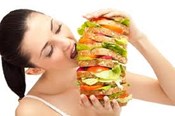I’ve been overweight all my life. Recently, I’ve read a little about what controls hunger and appetite. Are there foods I can eat that will help me feel fuller sooner, so I eat less?
As you suspect, the connection between eating and feeling full isn’t as simple as most people think. Scientists are still uncovering new information about the mechanisms involved.
For example, we’ve known for a while that eating foods high in protein may help us feel full more than when we eat carbohydrates or fats. Scientists are just now figuring out why. A French study published online in early July 2012 in the journal Cell shed some light: Apparently, peptides -- the product of digested proteins -- block the activity of certain nerve receptors in the gut. Blocking those receptors sends signals to the brain that in turn stimulates the intestine to release glucose, which suppresses the appetite. Knowing this provides more evidence for the benefits of including at least some lean protein in every meal.
A little fat in the food we eat also tends to help us feel fuller after eating. That’s one reason why dietitians caution us about blindly choosing low-fat versions of foods: The calorie difference between low-fat and “regular” foods may not be as great as you think, and if you don’t feel as satisfied after eating a low-fat food, you may end up eating more of it. Keep that in mind as you make your food choices.
High-fiber foods are other good choices. Fiber passes through the body undigested, so it provides bulk with few calories. Opt for naturally occurring fiber -- different types of fiber now added to some foods and beverages don’t have the same satiating effect.
Other things to consider include:
- Eat slowly. It takes about 20 minutes for the signals between your stomach and brain to make the connection that you’ve eaten enough.
- Stop when you feel satisfied -- don’t wait until you feel full. Try to gauge that internally, not by whether anything is left on your plate. If you can’t help but join the “clean-plate club” at most meals, serve yourself smaller portions. Pause before you serve yourself another helping, and do an internal check before making the decision.
- Eat breakfast. People who eat breakfast tend to be less likely to be overweight, although it’s not clear why. It could help you feel satisfied as you start the day, making impulse eating less likely. Good choices include high-fiber cereals or an egg -- both will help you feel satisfied and start your day off right.
Source: www.extension.org







